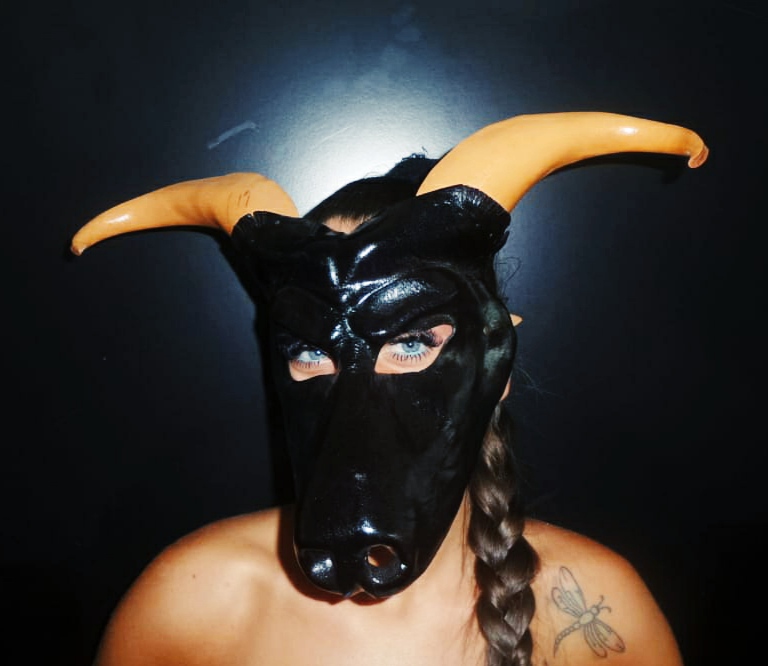This is a mask made by
leather which is completely handmade , according to the artisanal techniques of the ancient " maschereri " , the great mask craftmen.
We create our masks only using the best leather which comes from Tuscany ; the uniquestioned millenary capital in the tanning of the leather.
It's painted using appropriate colours which dye the leather and It's polished up using natural wax to give it the brightness.
There is inside our
certificate of guarantee and exclusivity.
It is realized with a material which makes it extremely comfortable and suitable to be worn thanks to the straps that you can easily adapt.
It's also appropiated as ornament to give a touch of fantasy to your rooms.
100% MADE IN ITALY - OUR PRODUCTION
STORY:
In Greek mythology, the Minotaur was a creature with the head of a bull on the body of a man. He dwelt at the center of the Cretan Labyrinth, which was an elaborate maze-like construction designed by the architect Daedalus and his son Icarus, on the command of King Minos of Crete. The Minotaur was eventually killed by the Athenian hero Theseus. The bronze "Horned God" from Enkomi, Cyprus After he ascended the throne of Crete, Minos competed with his brothers to rule. Minos prayed to Poseidon to send him a snow-white bull, as a sign of support (the Cretan Bull). He was to kill the bull to show honor to Poseidon, but decided to keep it instead because of its beauty. He thought Poseidon would not care if he kept the white bull and sacrificed one of his own. To punish Minos, Aphrodite made Pasiphaë, Minos' wife, fall deeply in love with the bull. Pasiphaë had the archetypal craftsman Daedalus make a hollow wooden cow, and climbed inside it in order to mate with the white bull. The offspring was the monstrous Minotaur. Pasiphaë nursed him in his infancy, but he grew and became ferocious, being the unnatural offspring of man and beast, he had no natural source of nourishment and thus devoured man for sustenance. Minos, after getting advice from the oracle at Delphi, had Daedalus construct a gigantic labyrinth to hold the Minotaur. Its location was near Minos' palace in Knossos. Nowhere has the essence of the myth been expressed more succinctly than in the Heroides attributed to Ovid, where Pasiphaë's daughter complains of the curse of her unrequited love: "The bull's form disguised the god, Pasiphaë, my mother, a victim of the deluded bull, brought forth in travail her reproach and burden.
"Theseus and the Minotaur: son of Minos, had been killed by the Athenians, who were jealous of the victories he had won at the Panathenaic festival. Others say he was killed at Marathon by the Cretan bull, his mother's former taurine lover, which Aegeus, king of Athens, had commanded him to slay. The common tradition is that Minos waged war to avenge the death of his son and won. Catullus, in his account of the Minotaur's birth, refers to another version in which Athens was "compelled by the cruel plague to pay penalties for the killing of Androgeos." Aegeus must avert the plague caused by his crime by sending "young men at the same time as the best of unwed girls as a feast" to the Minotaur. Minos required that seven Athenian youths and seven maidens, drawn by lots, be sent every seventh or ninth year (some accounts say every year) to be devoured by the Minotaur. When the third sacrifice approached, Theseus volunteered to slay the monster. He promised to his father, Aegeus, that he would put up a white sail on his journey back home if he was successful and would have the crew put up black sails if he was killed. In Crete, Minos' daughter Ariadne fell madly in love with Theseus and helped him navigate the labyrinth. In most accounts she gave him a ball of thread, allowing him to retrace his path. Theseus killed the Minotaur with the sword of Aegeus and led the other Athenians back out of the labyrinth. On the way home, Theseus abandoned Ariadne on the island of Naxos and continued. He neglected, however, to put up the white sail. King Aegeus, from his lookout on Cape Sounion, saw the black-sailed ship approach and, presuming his son dead, committed suicide by throwing himself into the sea that is since named after him. This act secured the throne for Theseus.
FROM : WIKIPEDIA
Others methods of payment , contact me at :
info@specialitaveneziane.it

